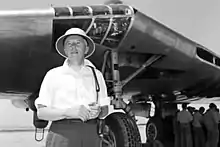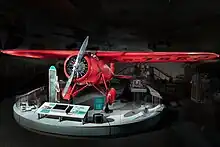Jack Northrop
John Knudsen Northrop (November 10, 1895 – February 18, 1981) was an American aircraft industrialist and designer who founded the Northrop Corporation in 1939.
Jack Northrop | |
|---|---|
 Northrop with the XB-35, circa 1948 | |
| Born | John Knudsen Northrop November 10, 1895 Newark, New Jersey, U.S. |
| Died | February 18, 1981 (aged 85) |
| Occupation(s) | Aeronautics Engineer Industrial Designer Businessman |
His career began in 1916 as a draftsman for Loughead Aircraft Manufacturing Company (founded 1912). He joined the Douglas Aircraft Company in 1923, where in time he became a project engineer. In 1927 he joined the Lockheed Corporation, where he was a chief engineer on the Lockheed Vega transport. He left in 1929 to found Avion Corporation, which he sold in 1930. Two years later, he founded the Northrop Corporation. This firm became a subsidiary of Douglas Aircraft in 1939, so he co-founded a second company named Northrop.[1]
Early life and entering aviation
Born in Newark, New Jersey in 1895, Northrop grew up in Santa Barbara, California. In 1916 Northrop's first job in aviation was in working as a draftsman for the Santa Barbara-based Loughead Aircraft Manufacturing Company. After the outbreak of the First World War, Northrop was drafted into the U.S. Army, where he served in the Army Signal Corps. Northrop served in the military for 6 months before Loughead successfully petitioned for his return to work in the private sector.[2] In 1923 Northrop joined Douglas Aircraft Company, where he participated in the design of the Douglas Round-the-World-Cruiser and worked up to project engineer.[3]

In 1927 he rejoined the Loughead brothers and their newly founded (in 1926) Lockheed Aircraft Company, working as chief engineer on the Lockheed Vega, the civilian transport monoplane with a cantilever wing that produced unusually high performance for that period, and was widely used by such top pilots as Wiley Post, Amelia Earhart, and Hubert Wilkins. In 1929 he produced an all-metal monoplane with an engine within the wing structure. Although this aircraft had booms to attach the tail group, it was in fact the first step toward the flying wing.[4]
Company founding
In 1929, Northrop struck out on his own, founding the Avion Corporation, which he was forced to sell to United Aircraft and Transport Corporation in 1930. In 1932, Northrop, backed by Donald Douglas of Douglas Aircraft, founded another company, the Northrop Corporation in El Segundo, California. This company built two highly successful monoplanes, the Northrop Gamma and Northrop Delta.[5]
By 1939 the Northrop Corporation had become a subsidiary of Douglas Aircraft, so Northrop founded another completely independent company of the same name in Hawthorne, California, a site located by Moye Stephens, one of the co-founders.[6]
Flying wing and other aircraft
While working at this company, Northrop focused on the flying wing design, which he was convinced was the next major step in aircraft design. His first project, a reduced-scale version tested in 1940, ultimately became the giant Northrop YB-35. The Northrop XP-56 Black Bullet, a welded magnesium fighter[7] was one of the more significant of his World War II designs, along with the Northrop P-61 Black Widow, the first American night interceptor, of which more than 700 were constructed.[8]
His inventions continued into the postwar era of jet aircraft, to produce the Northrop F-89 Scorpion all-weather interceptor, the Northrop YB-49 long-range bomber, the Northrop Snark intercontinental missile, and automatic celestial navigation systems. He produced a number of flying wings, including the Northrop N-1M, Northrop N-9M, and Northrop YB-35. His ideas regarding flying wing technology were years ahead of the computer and electronic advances of "fly-by-wire" stability systems which allow inherently unstable aircraft like the B-2 Spirit flying wing to be flown like a conventional aircraft.[9]
The flying wing and the pursuit of low drag high lift designs were Northrop's passion and its failure to be selected as the next generation bomber platform after World War II, and the subsequent dismantling of all prototypes and incomplete YB-49s, were a severe blow to him. He retired at age 57 in 1952 and virtually ended his association with the company for the next 30 years.[10][11]
Later years
He broke a decades-long silence on the Flying Wing's demise in a 1979 television interview,[12] accusing the Air Force of killing the project to punish him for refusing to merge his company with Consolidated Vultee. He alleged that Air Force Secretary Stuart Symington threatened him by saying, "You’ll be goddamned sorry if you don’t". Symington later left the government to head the very same Consolidated Vultee company Northrop had refused to merge with.[9] Symington called the charge "preposterous and absurd" and told a researcher[13] "There was a tremendous overcapacity in the industry following World War II". He said Northrop came to him, seeking more business to help his struggling company. Symington said, "I may very well have suggested that he merge his company with Convair, who we knew was going to get business."[9] Aviation expert Bud Baker, who studied declassified documents and public records and conducted personal interviews with Symington, Air Force generals and Northrop's chairman, concluded the cancellation "was a sound decision, based on budgetary, technical, and strategic realities."[13]
Northrop dabbled in real estate and lost much of his personal fortune. In 1976, with his health failing, he felt compelled to communicate to NASA his belief in the low drag high lift concept inherent in the flying wing. NASA replied that the idea had technological merit, encouraging Northrop that his flying wing concepts had not been completely abandoned. By the late 1970s a variety of illnesses left him unable to walk or speak. Shortly before his death, he was given clearance to see designs and hold a scale model of the Northrop Grumman B-2 Spirit stealth bomber, which shared design features of his YB-35 and YB-49.[14][15] The B-2, for example, has the same 172-foot wingspan as the jet-powered flying wing, YB-49.[15] Northrop reportedly wrote on a sheet of paper "Now I know why God has kept me alive for 25 years".[15] B-2 project designer John Cashen said, "As he held this model in his shaking hands, it was as if you could see his entire history with the flying wing passing through his mind."[16] He died ten months later.
Awards and honors
In 1947 he received the Spirit of St. Louis Medal from the American Society of Mechanical Engineers for "meritorious service in the advancement of aeronautics."[17] Investiture in the International Aerospace Hall of Fame came in 1972,[18] and in the National Aviation Hall of Fame in 1974.[19] He was posthumously inducted into the National Inventors Hall of Fame in 2003.[20]
Northrop's passion for tailless flight was honored by the naming of a giant tailless pterosaur Quetzalcoatlus northropi.[21][22]
Hawthorne Municipal Airport is also known as Jack Northrop Field in his honor.
See also
References
Notes
- Parker, Dana T. Building Victory: Aircraft Manufacturing in the Los Angeles Area in World War II, pp. 93-106, Cypress, CA, 2013; ISBN 978-0-9897906-0-4.
- Boyne, Walter (October 1, 2005). "The Low-Drag World of Jack Northrop". airforcemag.com. Retrieved September 24, 2022.
- "Spirit and Creator" 2002 Orbital Air Inc, Author Nova Hall pages 61-65
- "John K. Northrop" Archived 2016-03-04 at the Wayback Machine, allstar.fiu.edu; retrieved 13 September 2011.
- "Jack Northrop (1895-1981)". ctie.monash.edu.au. Retrieved: May 2, 2007.
- Parker, Dana T. Building Victory: Aircraft Manufacturing in the Los Angeles Area in World War II, pp. 93-106, Cypress, CA, 2013. ISBN 978-0-9897906-0-4.
- "XP-56 Black Bullet/42-38353" Archived 2011-04-02 at the Wayback Machine, nasm.si.edu; retrieved September 13, 2011.
- Parker, Dana T. Building Victory: Aircraft Manufacturing in the Los Angeles Area in World War II, pp. 94-97, Cypress, CA, 2013. ISBN 978-0-9897906-0-4.
- Correll, John T. (February 2017). "Jack Northrop and the Flying Wing". Air Force Magazine. Retrieved 18 February 2019.
- "The Wing Will Fly A dedicated team returns Jack Northrop's dream to the skies". AOPA. Aircraft Owners and Pilots Association. 10 May 1996. Retrieved 18 February 2019.
- "Jack Northrop: A Visionary's Bittersweet Legacy". Northrop Grumman Corporation. Archived from the original on 19 February 2019. Retrieved 18 February 2019.
- Bower, Cathy (March 10, 2014). "The Flying Wing: What Happened to It?". KCET. Retrieved 18 February 2019.
- Baker, Bud (Fall 2001). "Clipped Wings: The Death of Jack Northrop's Flying Wing Bombers" (PDF). Lessons Learned. Acquisition Review Quarterly. 8 (3): 197–219. ISSN 1087-3112. Archived from the original (PDF) on 19 February 2019. Retrieved 19 February 2019 – via Defense Acquisition University.
- Withington, Thomas; Davey, Chris (July 25, 2006). B-2A Spirit Units in Combat (Combat Aircraft). Osprey Publishing. p. 12. ISBN 978-1841769936.
- Rogoway, Tyler (September 7, 2015). "The Pointy End Of Northrop's Flying Wings Then And Now". Foxtrot Alpha. Jalopnik (Gizmodo Media Group). Retrieved 18 February 2019.
- "The Wing Will Fly". YouTube. Archived from the original on 2021-12-21. Retrieved 18 February 2019.
- "ASME: Spirit of St. Louis Medal". asme.org. Retrieved: March 5, 2008.
- Sprekelmeyer, Linda, editor. These We Honor: The International Aerospace Hall of Fame. Donning Co. Publishers, 2006. ISBN 978-1-57864-397-4.
- "John Northrop" Archived 2016-03-20 at the Wayback Machine. National Aviation Hall of Fame. Retrieved: April 2, 2011.
- "Jack Northrop". Archived 2010-12-06 at the Wayback Machine National Inventors Hall of Fame. Retrieved: September 13, 2011.
- Lawson, Douglas A. "Could Pterosaurs Fly?" Science, 188: 1975, pp. 676-678.
- Browne, Malcome (14 June 1991). "2 Rival Designers Led the Way To Stealthy Warplanes". NY Times. Retrieved 28 August 2018.
Bibliography
- Coleman, Ted. Jack Northrop and the Flying Wing: The Real Story Behind the Stealth Bomber. New York: Paragon House, 1988; ISBN 1-55778-079-X.
- Donald, David, editor. "Northrop Flying Wings". Encyclopedia of World Aircraft. Etobicoke, Ontario: Prospero Books, 1997; ISBN 1-85605-375-X.
- Maloney, Edward T. Northrop Flying Wings. Corona del Mar, California: World War II Publications, 1988. ISBN 0-915464-00-4.
- Pape, Garry and John Campbell. Northrop Flying Wings: A History of Jack Northrop's Visionary Aircraft. Atglen, Pennsylvania: Schiffer Publishing, Ltd., 1995; ISBN 0-88740-689-0.
- Pattillo, Donald M. "Pushing the Envelope: The American Aircraft Industry". Ann Arbor, Michigan: University of Michigan Press, 2001; ISBN 0-472-08671-5.
- Winchester, Jim. "Northrop XB-35/YB-49" Concept Aircraft: Prototypes, X-Planes and Experimental Aircraft. Kent, UK: Grange Books plc., 2005; ISBN 978-1-84013-809-2.
- Wooldridge, E. T. Winged Wonders: The Story of the Flying Wings. Washington, D.C.: Smithsonian Institution Press, 1983; ISBN 0-87474-966-2.